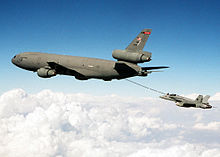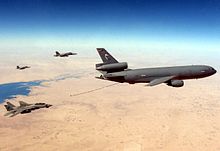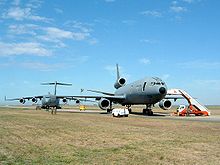- McDonnell Douglas KC-10 Extender
-
KC-10 Extender A United States Air Force KC-10 Extender refueling an F-16 Fighting Falcon Role Aerial refueling tanker, multi-role aircraft National origin United States Manufacturer McDonnell Douglas First flight 12 July 1980 Introduction March 1981 Status In service Primary users United States Air Force
Royal Netherlands Air ForceProduced KC-10: 1979–1987 Number built KC-10: 60; KDC-10: 2 Unit cost KC-10: US$88.4 million (FY1998)[1] Developed from McDonnell Douglas DC-10-30 The McDonnell Douglas KC-10 Extender is the military adaptation of the three-engined DC-10 airliner for the United States Air Force (USAF).[N 1] The KC-10 incorporates military-specific equipment for its primary roles of transport and aerial refueling. It was developed to supplement the KC-135 Stratotanker following experiences in Southeast Asia and the Middle East. The KC-10 was the second McDonnell Douglas transport aircraft to be selected by the Air Force following the C-9. A total of 60 KC-10s were produced for the USAF. Two similar tankers were sold to the Royal Netherlands Air Force under the designation KDC-10.
The KC-10 plays a key role in the mobilization of US military assets, taking part in overseas operations far from home. These aircraft participated in the 1986 bombing of Libya and 1999 NATO bombing of Yugoslavia, and more recently, Operations Enduring Freedom, Iraqi Freedom and Noble Eagle. However, the KC-10 was most notable for its participation in the Gulf War, where it was central to the airlift and aerial refueling effort. The aircraft is expected to serve until 2043.
Contents
Design and development
Requirement and design effort
The KC-10 Extender was born out of the need to augment the Air Force's large fleet of more than 700 Boeing KC-135 Stratotankers. During the Vietnam War, doubts began to be raised regarding the KC-135s' ability to meet the needs of the US' global commitments. The aerial refueling fleet was deployed to Southeast Asia to support tactical aircraft and strategic bombers, while maintaining the US-based support of the nuclear-bomber fleet. Consequently, the Air Force sought an aerial tanker with greater capabilities than the KC-135. In 1972 two DC-10s were flown in trials at Edwards Air Force Base, simulating air refuelings to check for possible wake issues. Boeing performed similar tests with a 747.[2]
During the 1973 Yom Kippur War, the Air Force commenced Operation Nickel Grass to supply Israel with weapons and supplies. The operation demonstrated the necessity for adequate air-refueling capabilities; denied landing rights in Europe, C-5 Galaxies were forced to carry a fraction of their maximum payload on direct flights from the continental United States to Israel.[3][4] To address this shortfall in mobility, in 1975, under the Advance Tanker Cargo Aircraft program, four aircraft were evaluated: the C-5 itself, the Boeing 747, the McDonnell Douglas DC-10, and the Lockheed L-1011.[5] The only serious contenders were McDonnell Douglas and Boeing, especially the latter, who thought they had the ideal offer. However, on 19 December 1977, the McDonnell Douglas KC-10 Extender was chosen. The primary reason of this choice was the KC-10's ability to operate from shorter runways.[4] Initially, a batch of 12 aircraft was ordered, but this figure was revised upwards to 60.[4]
 The KC-10's mixed refueling system of hose-and-drogue and flying-boom allow it to refuel the aircraft of the Air Force, Navy, Marine Corps and allied forces.[6]
The KC-10's mixed refueling system of hose-and-drogue and flying-boom allow it to refuel the aircraft of the Air Force, Navy, Marine Corps and allied forces.[6]
The KC-10 first flew on 12 July 1980, but it was not until October the same year that the first aerial refuel sortie was performed.[6][7] The design for the KC-10 involved modifications from the DC-10-30CF design. Unnecessary airline features were replaced by an improved cargo-handling system and military avionics.[8] Meanwhile, the KC-10 retains 88% commonality with its commercial counterparts, giving it greater access to the worldwide commercial support system.[4] Other changes from the DC-10-30CF include the removal of most cargo doors and windows.[9] Early aircraft featured a distinctive light gray, white and blue paint scheme, but a gray-green camouflage scheme was used on later tankers. Aircraft have since been switched to a medium gray color.[10]
However, the major changes were the addition of the McDonnell Douglas Advanced Aerial Refueling Boom (AARB) and extra fuel tanks below the main deck. The extra tanks increase the KC-10's fuel capacity to 356,000 lb (161,478 kg), nearly doubling the KC-135's capacity.[6] The KC-10 has both a centerline refueling boom and a drogue-and-hose system on the starboard side of the rear fuselage. The KC-10 boom operator is located in the rear of the aircraft with wide window for monitoring refueling. The operator controls refueling operations through a digital fly-by wire system.[10][11][1] Unlike the KC-135, the KC-10's hose-and-drogue system allows refueling of Navy, Marine Corps, and most allied aircraft, all in one mission.[6] The final twenty KC-10s produced included wing-mounted pods for added refueling locations.[2] In addition to its tanking role, the KC-10 can carry a complement 75 personnel with 146,000 lb (66,225 kg) of cargo, or 170,000 lb (77,110 kg) in an all-cargo configuration.[6]
Further developments
A need for new transport aircraft for the Royal Netherlands Air Force was first identified in 1984. In 1991 four categories of transport requirements were established. Category A required a large cargo aircraft with a range of at least 4500 km and the capability to refuel F-16s. In 1992, two DC-10-30CFs were acquired from Martinair in a buy/leaseback contract. When one of the bought aircraft was lost in the Martinair Flight 495 crash, a third aircraft was bought from Martinair.[12]
The conversion was handled via the United States foreign military sales program, which in turn contracted McDonnell Douglas. Costs for the conversion were initially estimated at $89.5 million (FY 1994). The aircraft was to be equipped with both a boom and a probe and drogue system. However, because McDonnell Douglas did not have any experience with the requested Remote Aerial Refueling Operator (RARO) system, and because the third aircraft differed from the original two, the program could not be completed at budget. By omitting the probe and drogue system and a fixed partition wall between the cargo and passenger, the cost could be limited at $96 million. To make up for the cost increase McDonnell Douglas hired Dutch companies to do part of the work. The actual converting of the aircraft for instance was done by KLM. Conversion of the aircraft was done from October 1994 to September 1995 for the first aircraft and from February to December 1995 for the second. This was much longer than planned, mostly because McDonnell Douglas did not deliver the parts in time. This would have again increased the cost, but in the contract for the AH-64 Apaches which the Royal Netherlands Air Force also bought from McDonnell Douglas, the price was agreed to be kept at $96 million.[12]
In an attempt to modernize the platform, the USAF has awarded Boeing a US$216 million contract to upgrade its fleet of 59 aircraft with new communication, navigation, surveillance and air traffic management (CNS/ATM) system. Boeing claims that this will allow the aircraft to fly in civil airspace after 2015 as new ICAO and FAA standards take effect.[13]
Operational history
United States
The first KC-10s was delivered to the Air Force's Strategic Air Command (SAC) in March 1981 at Barksdale AFB; the 60th and final KC-10 arrived on 29 November 1988.[14] The KC-10s served with SAC until 1992, when they were re-assigned to the newly-established Air Mobility Command. In the aerial refueling role, the KC-10s have been operated largely in the strategic refueling of large number of tactical aircraft on ferry flights and the refueling of other strategic transport aircraft. Conversely, the KC-135 fleet has operated largely in the in-theater tactical role. There are 59 KC-10 Extenders in service with the USAF as of 2010.[1][13] The USAF's KC-10s are stationed primarily at Travis AFB, California, and McGuire AFB, New Jersey.
 A USN F-14D and two F/A-18Cs prepare to refuel from a KC-10 in 2005 over the Persian Gulf.
A USN F-14D and two F/A-18Cs prepare to refuel from a KC-10 in 2005 over the Persian Gulf.
When faced with refusals of basing and overflight rights from continental European countries during Operation El Dorado Canyon, the U.S. was forced to use the UK-based F-111s in the 1986 air-strikes against Libya. The KC-10s and KC-135s allowed 29 F-111s, along with other Air Force and Navy aircraft, to reach their targets.[15] The KC-10 again played a key role during Operations Desert Shield and Desert Storm in 1991; KC-10s facilitated the deployment of tactical, strategic, and transport aircraft to Saudi Arabia. In the early stages of Operation Desert Shield, aerial refueling was key to the rapid airlift of materiel and forces. In addition to refueling airlift aircraft, the KC-10, along with the smaller KC-135, moved thousands of tons of cargo and thousands of troops in support of the massive buildup. The KC-10 and the KC-135 conducted about 51,700 separate refueling operations and delivered 125 million gallons (475 million liters) of fuel without missing a single scheduled rendezvous.[1]
Since then, the KC-10 had participated in other smaller conflicts. In March 1999, NATO launched Operation Allied Force against the government of Yugoslavia. The mobility portion of the operation began in February and was heavily dependent on tankers. By early May 1999, some 150 KC-10s and KC-135s deployed to Europe where they refueled bombers, fighters and support aircraft engaged in the conflict. The KC-10 flew 409 missions throughout the entire Allied Force campaign and continued support operations in Kosovo.[1] Since 11 September 2001, KC-10s had also flown more than 350 missions guarding U.S. skies as a part of Operation Noble Eagle. During Operations Enduring Freedom and Iraqi Freedom, KC-10s have flown more than 1,390 missions delivering critical air refueling support to numerous joint and Coalition receiver aircraft.[1] KC-10s are expected to serve until 2043.[16]
Netherlands
The two Dutch KDC-10s, T-264 "Prins Bernhard" and T-235 "Jan Schäfer", are used for both refueling and transport. They are stationed on Eindhoven Airport as part of the 334th Transport Squadron.[17] Of the 5,500 hours flown in the first 3 years of use, the aircraft were used in their tanker role for 50% of the time. Besides being used by the air force and NATO allies, the KDC-10s are also used to support peacekeeping and humanitarian aid operations. Of the first three years, 32% of the flight hours were used for peacekeeping and humanitarian aid.[12]
In this function, the aircraft have been deployed to Kosovo to evacuate refugees, to the Caribbean and Central America to provide humanitarian aid after the hurricanes Luis, Georges and Mitch and to various countries in Africa and Asia to provide development aid. In 1998, the aircraft were also used to evacuate Dutch citizens from Indonesia during the Fall of Suharto. Dutch KDC-10s have been operating out of Manas AFB in support of allied forces during Operation Enduring Freedom.
Civilian operators
Commercial refueling companies Omega Air and Global Air Tanker Service operate two KDC-10 tankers (N974VV and N852V, respectively) for lease.[18][19] They were converted from DC-10-40s and provide both boom, and probe and drogue refueling capabilities.[20] In June and July 2011, Omega Air's KDC-10 supported 3 of Royal Australian Air Force's F/A-18 Hornets, en-route to Red Flag – Alaska.[21]
Operators
 A KC-10 (right foreground) and C-17 (left background) at Avalon Airport, Australia, for the 2005 Australian International Airshow
A KC-10 (right foreground) and C-17 (left background) at Avalon Airport, Australia, for the 2005 Australian International Airshow
- United States Air Force operates 59 KC-10 aircraft as of November 2010.[1]
- Royal Netherlands Air Force operate 2 KDC-10s.
- 334th Squadron – Eindhoven Airport
Incidents
On 17 September 1987, KC-10A serial number 82-0190 was undergoing maintenance on the ground at Barksdale AFB, Louisiana and suffered an explosion and subsequent fire. The KC-10 was significantly damaged and written-off. One member of the ground crew, the crew chief, Sgt. Joseph M. Burgio died in the fire.[22]
Specifications (KC-10A)
 External images
External imagesMcDonnell Douglas KC-10A Cutaway 
McDonnell Douglas KC-10A Cutaway from Flightglobal.com Data from USAF Fact sheet,[1] Steffen[23]
General characteristics
- Crew: 4 (pilot, copilot, flight engineer, boom operator) and additional crewmembers such as an aeromedical evacuation team may be added
- Length: 181 ft 7 in (54.4 m)
- Wingspan: 165 ft 4.5 in (50 m)
- Height: 58 ft 1 in (17.4 m)
- Wing area: 3,958 ft² (367.7 m²)
- Empty weight: 241,027 lb (109,328 kg)
- Loaded weight: 593,000 lb (269,000 kg)
- Max takeoff weight: 590,000 lb (267,600 kg)
- Powerplant: 3 × F103/General Electric CF6-50C2 turbofans, 52,500 lbf (236 kN) each
- Maximum fuel capacity: 356,000 lb (160,200 kg)
Performance
- Maximum speed: 538 knots (619 mph, 996 km/h)
- Range: 4,400 mi (7,032 km)
- Ferry range: 11,500 mi (18,507 km)
- Service ceiling: 42,000 ft (12,727 m)
- Rate of climb: 6,870 ft/min (34.9 m/s)
See also
- Related development
- Aircraft of comparable role, configuration and era
- Airbus A330 MRTT
- Boeing KC-135 Stratotanker
- Boeing KC-767
- EADS/Northrop Grumman KC-45
- Lockheed TriStar (RAF)
- Ilyushin Il-78
- Related lists
References
- Notes
- ^ The Handley Page Jetstream had been initially ordered as the C-10A, but was soon cancelled. This allowed the tanker version of the DC-10 to be designated KC-10A.
- Citations
- ^ a b c d e f g h "Factsheets: KC-10 Extender". US Air Force. http://www.af.mil/information/factsheets/factsheet.asp?id=109. Retrieved 27 August 2011.
- ^ a b Waddington 2000, pp. 116–120.
- ^ Endres 1998, p. 65.
- ^ a b c d Steffan 1998, p. 103.
- ^ Frawley 2002, p. 119.
- ^ a b c d e Steffan 1998, p. 104.
- ^ "KC-10A Extender: Background". Globalsecurity.org. http://www.globalsecurity.org/military/systems/aircraft/kc-10-background.htm. Retrieved 27 August 2011.
- ^ Eden 2004, p 286.
- ^ "KC-10A Extender: Characteristics". Globalsecurity.org. http://www.globalsecurity.org/military/systems/aircraft/kc-10-characteristics.htm. Retrieved 27 August 2011.
- ^ a b Steffen 1998, pp. 103–107.
- ^ Eden 2004, p 287.
- ^ a b c "Kamerbrieven: Evaluatie KDC-10" (in Dutch). Ministerie van Defensie, 1 July 1999. http://www.mindef.nl/actueel/parlement/kamerbrieven/1999/3/010799_evaluatie.aspx. Retrieved 22 February 2008.[dead link]
- ^ a b Trimble, Stephen. "Boeing outlines C-130H and KC-10 cockpit upgrades". Flightglobal.com. http://www.flightglobal.com/articles/2010/06/24/343673/boeing-outlines-c-130h-and-kc-10-cockpit-upgrades.html. Retrieved 19 September 2010.
- ^ Steffen 1998, pp. 104, 107.
- ^ "Operation El Dorado Canyon". Globalsecurity.org. http://www.globalsecurity.org/military/ops/el_dorado_canyon.htm. Retrieved 27 August 2011.
- ^ Veronico and Dunn 2004, p. 58.
- ^ Steffen 1997, pp. 106–107.
- ^ "Frequently Asked Questions". Omega Air Refueling. http://www.omegaairrefueling.com/FAQs.htm#Question3. Retrieved 27 August 2011.
- ^ "KDC-10 Air Refueling Tanker Aircraft." Global Airtanker Service. Retrieved: 19 September 2010.
- ^ "KDC-10: Primary Options." Global Air Tanker Services. Retrieved: 25 February 2008.
- ^ "RAAF Hornets Participate in Red Flag Alaska" Air Forces Monthly (Key Publishing), Issue 282, September 2011, pp. 37. ISSN 09557091. Retrieved: 30 September 2011.
- ^ "McDonnell Douglas KC-10A 82-0190." Aviation Safety Network Database. Retrieved: 19 September 2010.
- ^ Steffen 1998, p. 107.
- Bibliography
- Eden, Paul, ed (2004). The Encyclopedia of Modern Military Aircraft. London: Amber Books. ISBN 1-904687-84-9.
- Endres, Gunter (1998). McDonnell Douglas DC-10, Volume 10. Grand Rapids, Michigan: Zenith Imprint. ISBN 9780760306178.
- Frawley, Gerard (2002). The International Directory of Military Aircraft, 2002–2003. Fyshwick, Australia: Aerospace Publications. ISBN 1-875671-55-2.
- Steffen, Arthur A. C. (1998). McDonnell Douglas DC-10 and KC-10 Extender. Hinckley, Leicester, UK: Midland Publishing. ISBN 1-85780-051-6.
- Veronico, Nick; Dunn, Jim (2004). 21st Century U.S. Air Power. Grand Rapids, Michigan: Zenith Imprint. ISBN 9780760320143. http://books.google.com/books?id=3zz3KLbOvYUC&pg=PA83&dq=E-3+Sentry&hl=en&ei=MvZOTtq0Eo3ymAW3w_nwBg&sa=X&oi=book_result&ct=book-preview-link&resnum=10&ved=0CF4QuwUwCQ#v=onepage&q&f=false.
- Waddington, Terry (2000). McDonnell Douglas DC-10. Miami, Florida: World Transport Press. ISBN ISBN 1-892437-04-X.
External links
- KC-10 page on Boeing.com
- USAF KC-10 fact sheet
- KC-10 web site
- KC-10 fact sheet on TheAviationZone.com
- KDC-10 in the Dutch Air Force
- KC-10 CLS Competition
- McDonnell Douglas promotional video of the KC-10 Extender on YouTube
McDonnell and McDonnell Douglas military aircraft and spacecraft Fighters USAAF/US Air ForceUS Navy/USMCExportLicensedAttack US Navy/USMCTrainers US NavyTransports US Air ForceUS NavyLicensedHelicopters US Army/US Air ForceUS NavyXHJH · XHCH · XHRH
ExportDrones (UAVs) US NavyKDH
Experimental US Army/US Air ForceXV-1 · X-36 · F-15 STOL/MTD · Bird of Prey
Spacecraft NASAUS Air ForceUnited States tri-service transport designations post-1962 C-1 · C-2 · C-3 · C-4 · C-5 · C-6 · C-7 · C-8 · C-9 · KC-10 · C-11 · C-12 · (C-13 not assigned) • C-14 · C-15 · (C-16 not assigned) • C-17 · C-18 · C-19 · C-20A/B/C/D · C-20F/G/H · C-21 · C-22 · C-23 · C-24 · C-25 · C-26 · C-27 / C-27J · C-28 · C-29 · (C-30 not assigned) • C-31 · C-32 · C-33 · C-35 · (C-36 not assigned) • C-37 · C-38 · C-40 · C-41 · (C-42 to C-44 not assigned) • KC-45 • KC-46
United States Military Aerial Refueling Aircraft Active Planned KC-46
Retired Cancelled Lists relating to aviation General Aircraft (manufacturers) · Aircraft engines (manufacturers) · Airlines (defunct) · Airports · Civil authorities · Museums · Registration prefixes · Rotorcraft (manufacturers) · TimelineMilitary Accidents/incidents Records Categories:- United States military tanker aircraft 1980–1989
- Air refueling
- 1981 introductions
- Trijets
Wikimedia Foundation. 2010.


